 |
| Members of the South Carolina Sons of the American Revolution (SC SAR) and other members and reenactors honoring those men who fell at the Battle of Kings Mountain (Oct. 7, 1780). |
On Wednesday, October 7th of this year, I had the opportunity to visit one of my favorite historical site in the South Carolina upcountry, the Kings Mountain National Military Park and observe the 235th Anniversary of the Battle Of Kings Mountain (October 7, 1780).
Traveling along with me was my brother, Alex, who helped take some of the following photos of the trip along the park trail and the Laying of the Wreaths ceremony that took place at 11 AM on the battlefield site.
The following photos chronicle this little adventure.
 |
| Kings Mountain National Military Park Visitors Center. |
 |
| Clothing of the type worn by the Patriot Militia from the backcountry and Over-The-Mountain Regions at the battle. |
 |
| Also typical clothing worn by both the Patriot Militia and the British Loyalist Militia at the battle. |
 |
| The famous "Ferguson Rifle" designed by Major Patrick Ferguson. The story of this rifle I chronicled in a previous blog post. |
 |
| Map detailing the British Campaign in South Carolina in the summer and fall of 1780. |
 |
| Your humble blogger standing on the Kings Mountain Battlefield Trail. |
 |
| My brother Alex Wallen. |
 |
| The Chronicle Marker. The spot where Patriot Major William Chronicle fell during the battle. |
 |
| Both during and after the battle, men on both sides used this creek as a source of water. |
As my brother and I walked the trail around the site where the Patriot forces surrounded the base of the large, rock-covered hill that makes up the Kings Mountain battlefield, I could not help but look at the early autumn foliage and remember that it was on the same date 235 years before that the battle took place.
The American Loyalists and the Patriot Militiamen who fought here on that afternoon must have seen some of the same fall colors. For some of them it would have been their last sight as they lay wounded or dying.
The American Loyalists and the Patriot Militiamen who fought here on that afternoon must have seen some of the same fall colors. For some of them it would have been their last sight as they lay wounded or dying.
In point of fact, I would like to add that in the fall of 1780 Kings Mountain itself was covered with an old growth forest with trees far thinker -- in some cases almost redwood sized -- than the forest that surrounds the battlefield today. Those old trees were so thick and wide, the Patriots could take cover and be safe around them as they fired up at the Loyalists silhouetted against the sky on top of the large hill, which was then and still is barren of trees.
 | |
| Probably the last thing many would expect to find on a Revolutionary War battlefield is a monument to a Confederate officer. This marker and plaque recognizes Colonel Asbury Coward, a resident of York, South Carolina who was instrumental in establishing the park. Coward served as a colonel in the 5th South Carolina Infantry Regiment (CSA) during the War Between the States and had opened the Kings Mountain Military Academy at York before the war. His cadets came to the battleground to drill annually. After the war, with the support of the Daughters of the American Revolution, Coward helped foster interest in a park at Kings Mountain. The stone and plaque were placed here in 1931 to honor his memory. *See a previous blog post here to see the grave of Colonel Asbury Coward in York, South Carolina. |
We both arrived at the US Monument at the top of the hill just in time for the beginning of the annual Laying Of The Wreaths ceremony celebrating the 235th Anniversary of the Battle of Kings Mountain.
The event is sponsored by the North and South Carolina Societies of the Sons of the American Revolution. Members of the Sons of the American Revolution and Daughters of the American Revolution from many states were in attendance and provided wreaths in memory of those who fought at the battle. Reenactors portraying the American Patriots (and a few American Loyalists) were also in attendance.
After several speeches were made by representatives of the SAR and DAR, the wreaths were presented and the representatives of close to 100 chapters of both fraternal heritage organizations and various re-enactor groups. It was truly an amazing time and I know the photos I took cannot do it justice.
 |
| Arriving at the large US Monument on top of the hill. It was placed there in 1909 by the US Government on the site where Ferguson's Loyalist forces surrendered in their campsite. |
 |
| A wide shot of the massed colors and wreaths that honor the fallen American Patriots who died during the battle and the veterans who survived. |
 |
| Reenactors firing a ceremonial volley in memory of the fallen. |
 |
| Closing Prayer. |
 |
| Plaque dedicated to those Patriot Militiaman killed and wounded during the battle. |
 |
| Plaque dedicated to the victory at Kings Mountain. |
 | |||
| Yours truly posing in front of the US Monument with the Betsy Ross Flag representing the original thirteen united States of America. |
 |
| The arrival of the Overmountain Victory Trail Association reenactors. These dedicated folks annually march the same path taken by the Overmountain Men -- a two week trek from Abingdon, Virginia following the Overmountain Victory National Historic Trail to the Kings Mountain National Military Park. |
 |
| Marker dedicated to Patriot Colonel James Hawthorne who died at the battle. |
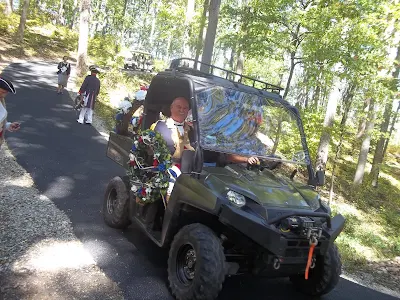 |
| Some reenactors coming back down from the top in style. |
The final stop on my trip was the grave of Colonel Patrick Ferguson, which sits not far from the spot where he was shot from his horse. The marker was placed there in the 1930s in memory of the fallen Scottish officer. Beneath the cairn of stones behind the marker lies Ferguson's grave.
Also buried beside Ferguson in an unmarked grave is a camp follower named Virginia Sal. She was believed to have been Ferguson's lover. Sal was shot and killed in the crossfire during the battle while tending to the wounded Loyalists -- her red hair possibly making her a target through the smoke.
Several reenactors placed stones as they passed by. I likewise placed two stones on the cairn out of respect for the fallen British officer from Scotland who died so far from his home, and for Virginia Sal. It is part of an old Celtic tradition to place stones on the graves of the dead in their memory. An old Scottish Gaelic blessing is: Cuiridh mi clach air do charn (which translated means: "I'll put a stone on your cairn").
Overall, I have to say a good time. It was an huge honor to be there to help pay tribute to the Southern-born Patriot militiamen - most of them Scots-Irish - who defeated the Loyalists on that early autumn day in October of 1780. America would not be the nation that it is without the efforts of those who fought there. Their success literally turned the tide of the American Revolution in the South in favor of the Continentals and Patriots.
I hope y'all enjoyed this blog post as much as I enjoyed writing it and posting the photos. Be sure to check out the links in the blog post to learn more about various aspects of the Battle of Kings Mountain and the men who fought there.
I hope y'all enjoyed this blog post as much as I enjoyed writing it and posting the photos. Be sure to check out the links in the blog post to learn more about various aspects of the Battle of Kings Mountain and the men who fought there.






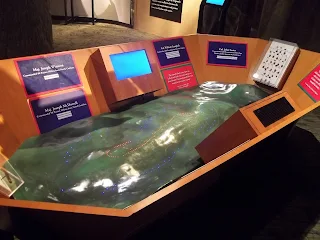





















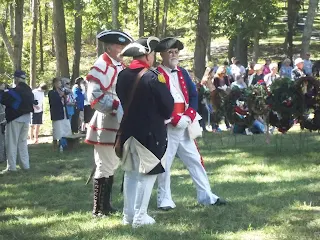
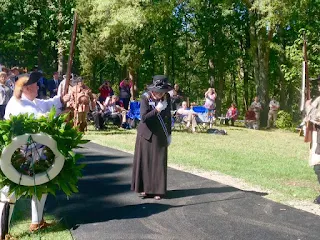




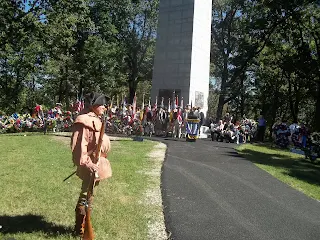








No comments:
Post a Comment